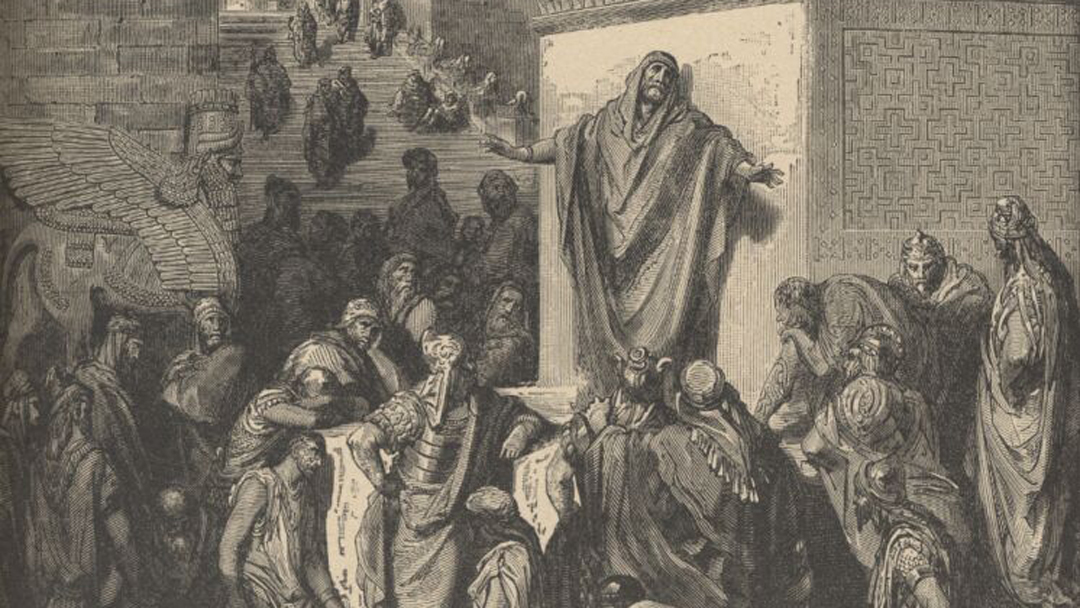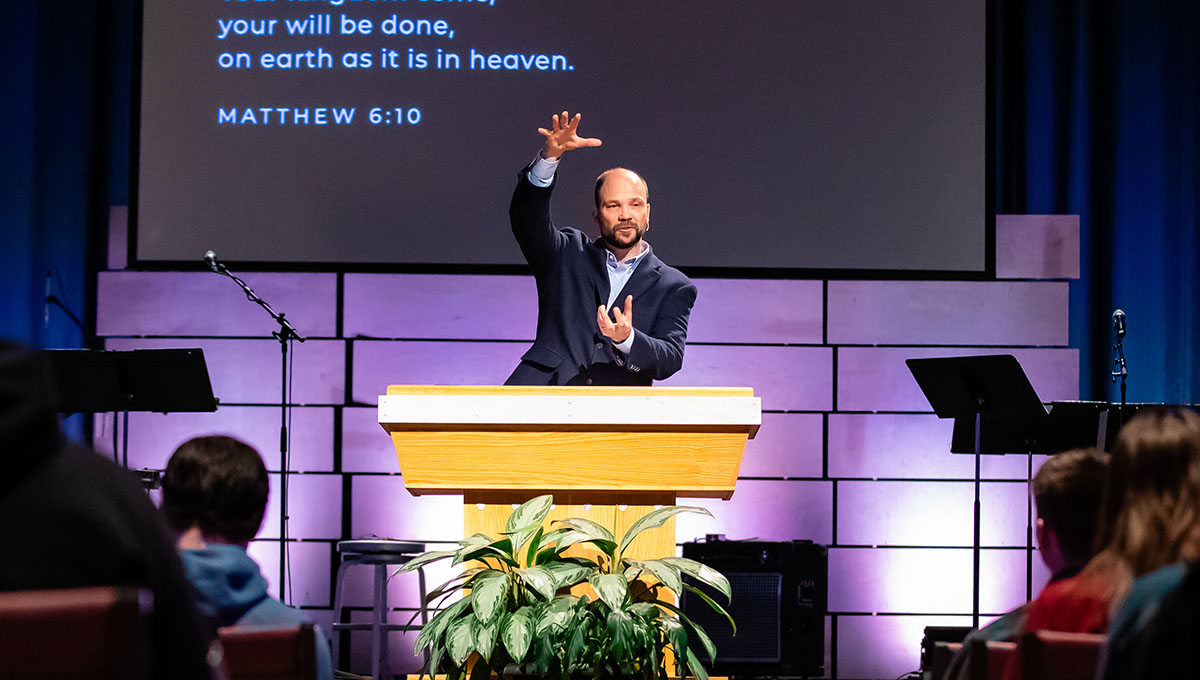Behind the Scenes
- Nathan Schneider

James 5:16 instructs us to confess our sins to one another. So here it goes. Forgive me, for I have sinned. It’s been nearly a month since my last blog post.
Indeed, it’s been rather hectic the past several weeks, but with Resurrection Sunday having passed, I’ve finally come to a much needed, albeit short, moment of relief before the month of May overtakes us all. Indeed, it’s hard to believe we’re staring Spring straight in the face after what has felt like, in my humble opinion, a rather long winter.
As I’ve mentioned in previous posts, I’m currently teaching Hebrew Grammar to several seminary students, and what makes second semester Hebrew so much fun is that the last two-thirds of the semester is devoted almost entirely to translation. By the end of the year, these men will have translated through 1 Samuel 16, Genesis 37, Psalm 103, as well as the entire book of Jonah. In the process, we talk about Hebrew grammar a lot. We investigate how the language works so that the men have the necessary skills to identify words, particularly verbs, and recognize what the root word is.
But because we’re studying the Bible while we study language, we can’t but also talk about the text itself, and this is one of the true highlights of the class. We get to see how just how nuanced the text is in its original language, and some of the most memorable parts of the class are the discussions we have over the meaning of the text (in light of the language) and its impact on us, our church, or families, and our societies.
The book of Jonah stands out particularly amid these discussions. The book is well known to most every one with some familiarity of the Bible, even if it’s nothing more than knowing it’s the story about the fish eating a man. But for more diligent students of the Scriptures, Jonah is a treasure-trove of theology, worldview, and biblical ethics that would take weeks to unpack. I don’t want to do that here. Instead, I just want to talk about one thing related to Jonah that might not have been discussed when you last heard Jonah taught in Sunday School when you were five.
The Book of Jonah, of course, is a narrative following a prophet of Yahweh named “Jonah son of Amittai,” who lived during the reign of Jeroboam II (2 Kgs. 14:23–25), who ruled over the northern kingdom of Israel from 793–758 B.C. The book chronicles Yahweh’s call of his prophet Jonah to travel to the “great city” Nineveh and issue a proclamation of imminent overthrow (Jon 3:4). But rather than follow God’s instruction, the prophet flees from God, the reasons for which aren’t revealed until the events and dialogue of the final chapter.
What’s interesting, though, is the recipients of this prophetic message and their response to the warning of Jonah. Having heard Jonah’s message that “in forty days and Nineveh will be overthrown,” it says “the people of Nineveh believed God. They called for a fast and put on sackcloth, from the greatest of them to the least of them” (Jon. 3:4–5). The king of Nineveh then makes an official decree calling for a total fast of man and animal, as well as mourning rites and earnest prayers (Jon. 3:6–9). The third chapter concludes with the statement, “When God saw what they did, how they turned from their evil way, God relented of the disaster that he had said he would do to them, and he did not do it” (Jon. 3:10).
Perhaps most people would read this account of Nineveh’s repentance and simply accept it at face value without asking further questions. But for those of us like myself, Nineveh’s repentance poses several questions, not the least of which is this: why would a city like Nineveh, known for its great evils and atrocities (cf. Jon. 1:2; 3:8, 10), suddenly repent after hearing the words of a foreign prophet?
Nineveh’s roots as a city go back 7,000 years, at least according to the earliest archaeological evidence of occupation at the site. It was first mentioned in Gen. 10:11–12 as one of several cities build by Nimrod as he traveled from the land of Shinar in Babylonia. At the time of Jonah near the end of the 8th century B.C., Nineveh was one of several major cities that made up the mighty and ferocious Assyrian empire, although it would not become the capital of the empire until the day so Sennacherib (705–681 B.C.).
Interestingly, Nineveh is one of only three cities in the OT described as being a “great city” (Jon. 1:2; 3:2; cf. 4:11), the two others being Jerusalem (Jer. 22:8) and Gibeon (Josh. 10:2). Such a designation points more to the importance of the city and not necessarily its size, although 3:3 specifically states that “Nineveh was an exceedingly great city” (literally in the Hebrew: “Nineveh was a great city to God,” which most Hebrew scholars identify as a Hebraic superlative), and then describes it as “a journey of three days.” This description has garnered quite a few interpretations, not all of them as strong as others. Some have thought that this is a reference to the city’s diameter, and others to its circumference. However, in either case the distance proves to be far greater than any city of the time could have sustained. If one figures an average of 17 miles per day (a modest pace, especially since most dignitaries at the time would have ridden atop an animal), then the city would have been over 50 miles across. This conundrum has led to alternative interpretations, including the view that the distance describes the larger environs of the city known as the “Assyrian triangle,” or that it is a reference the time needed to travel to the city, conduct business, and then return home.
Regardless of the correct approach, there’s no mistaking the text’s emphasis on the impressive size and significance of the city of Nineveh. In 4:11, God speaks of the city as containing a population of “120,000 persons who do not know their right hand from their left and also much cattle.” Traditionally, this has been understood to refer to infants and small children and thus inferring a total population of upwards to 600,000 people, although others understand it as a reference to moral accountability and divine revelation and thus see the entire population of the city as 120,000.
What isn’t indicated in the text of Jonah but discovered from other Ancient Near Eastern sources is that Jeroboam II’s reign over northern Israel coincided with a period of diminished strength in the Assyrian empire allowing for Jeroboam to enjoy a relatively long reign where he could expand Israel’s borders considerably with little resistance.
But other things were going on also, things which on the surface seem like mere coincidence but on a second take may perhaps prove to be the sovereign and providential hand of God.
The first would seem to be the onset of famine. At the time, the kind of Assyria was Assur-Dan III, and there are several references in the Assyrian historical annals to famines that occurred over a period of seven years beginning in 765 B.C. and either occurring again in 759 B.C. or stretching across the entire seven-year period. A comparison of Assyrian omen texts indicates that famine and plagues were viewed as portents of disaster and divine upheaval calling for national mourning in order to avert them.
Second, at some point during this period of time, a massive earthquaked shook the land. It was evidently a tremor of significant magnitude, for it is noted at the beginning of the book of Amos (“…two years before the earthquake” [1:1]) as well as by Zechariah, who references it as the only natural phenomenon comparable to the events that will take place when Messiah returns and his feet land on the Olivet Mount and split it down the middle (Zech. 14:4–5). Like plagues and famine, most Ancient Near Eastern peoples interpreted earthquakes as indicative of divine judgment, and the Assyrians were no different. Statements from Assyrian omen texts include assertions such as, “When the god of Adod is angry the earth trembles,” and “When you O god (Ninurta) march, heaven and earth quake” (quoted from Wiseman, “Jonah’s Nineveh,” 47). It is significant to note that earthquakes are reported to have occurred during the reign of Assur-Dan III, contemporary with Jeroboam II of Israel.
Third, on June 15, 763 B.C. a total eclipse of the sun occurred which obliterated the sun’s light and was recorded in the Assyrian historical records. Now, we’re so used to solar eclipses as predictable natural phenomena that we don’t appreciate the enormous religious and portending significance they carried in ancient cultures. Wiseman writes, “The rarity of the total eclipse always portended something of special significance and pointed to a major public disaster. While affecting individuals the predictions were not aimed at them but at the country as a whole or at the royal family and nobles at the overthrow of the dynasty and city” (ibid., 45). Wiseman goes on to describe the content of these omen texts related to total eclipses:
The predictions related to such eclipses usually, as recorded in the Nineveh verions of Enuma Anu Enlil, include such statements as ‘the king will be deposed and killed and a worthless fellow seize the throne’; ‘the king will die, rain from heaven will flood the land. There will be famine’; ‘a deity will strike the king and fire consume the land’; ‘the city-walls will be destroyed.’ (ibid., 46).
In addition to these predictive statements, other texts explain the required response from the people in the event that a total eclipse occurred. Wiseman writes, “A total eclipse is to be a time of solemn fasting when the king hands over the throne to a substitute king (of Nineveh) until the danger passes. . . . A related series of omens, summa alu, stating the effects of the divine wrath upon the city, concentrates on the actions of animals also at such a time. Thus all prognostications in the Assyrian series telling of solar eclipses specify their effect on the king, animals and the land, as does Jonah (3:7–8), which also specifies that the king stepped down from the throne and laid aside his royal robes (3:6)” (ibid., 47).
Finally, in likely response to the combination of famine, earthquakes, and solar eclipse, a series of rebellions arose in various cities in the empire leading to the Assyrian king’s absence from Nineveh for a period of around two years.
Now, when we begin to put all of this together within the context of Jonah, we begin to see the mysterious hand of God at work. We read in the narrative account, “Jonah arose and went to Nineveh. . . and called out, ‘Yet forty days, and Nineveh shall be overthrown!” (3:2, 4) We read that “the people of Nineveh believed God” and “called for a fast and put on sackcloth” (3:5). We read that the king of Nineveh “arose from his throne, removed his robe, covered himself with sackcloth, and sat in ashes” (3:6). We read that he issued a royal proclamation that said, “Let neither man nor beast, herd nor flock, taste anything. Let them not feed or drink water, but let man and beast be covered with sackcloth, and let them call out mightily to God. Let everyone turn from his evil way and from the violence of his hands. Who knows? God may turn and relent and turn from his fierce anger, so that we may not perish” (3:7–9). But was this response an immediate, out-of-the-blue reaction to a foreign prophet’s warning of divine wrath? I think not.
I think God had been preparing Nineveh for this moment. I think God had been working on these people perhaps over the course of a decade in preparation for his prophet to come and warn them that should they continue in their present course, they would meet destruction. Their actions seem to align perfectly with such an inference. And in this way, it’s such a beautiful reminder that often times the Lord is doing things in the background that seem unapparent to us, yet he is guiding us toward his sovereign ends for his purposes. We might look on things like famine, tremors, and a solar eclipse and see them as natural phenomena, perfectly explainable through scientific processes. And they are! There’s no indication that any of these particular events were some type of supernatural things outside of scientific explanation. And yet they weren’t just natural events. They really were sent by God and used by God to soften the hearts of Israel’s enemies so they would be ready to respond correctly to his message.
This is the providential hand of God at work. We can’t always see that providence happening at the moment. Events don’t come with instructions and explanations as to why they’re happening and what God’s using them for. Just like with Nineveh, it’s not until afterward, when we’re surveying the scene, do we begin to uncover the fingerprints of God touching every circumstance. Only then do we begin to recognize that this was no accident, no coincidence. This was God working behind the scenes, arranging his creation in such a way that through the natural processes of life and the universe, he is accomplishing his appointed ends. That’s something only a sovereign God can do—manage and direct all the tiny details of the universe toward one end…his end. And in that sense, we really have no idea what God is doing behind the scenes. And we don’t have to. We just have to know he’s doing it. And in some ways, that’s the hardest part.










